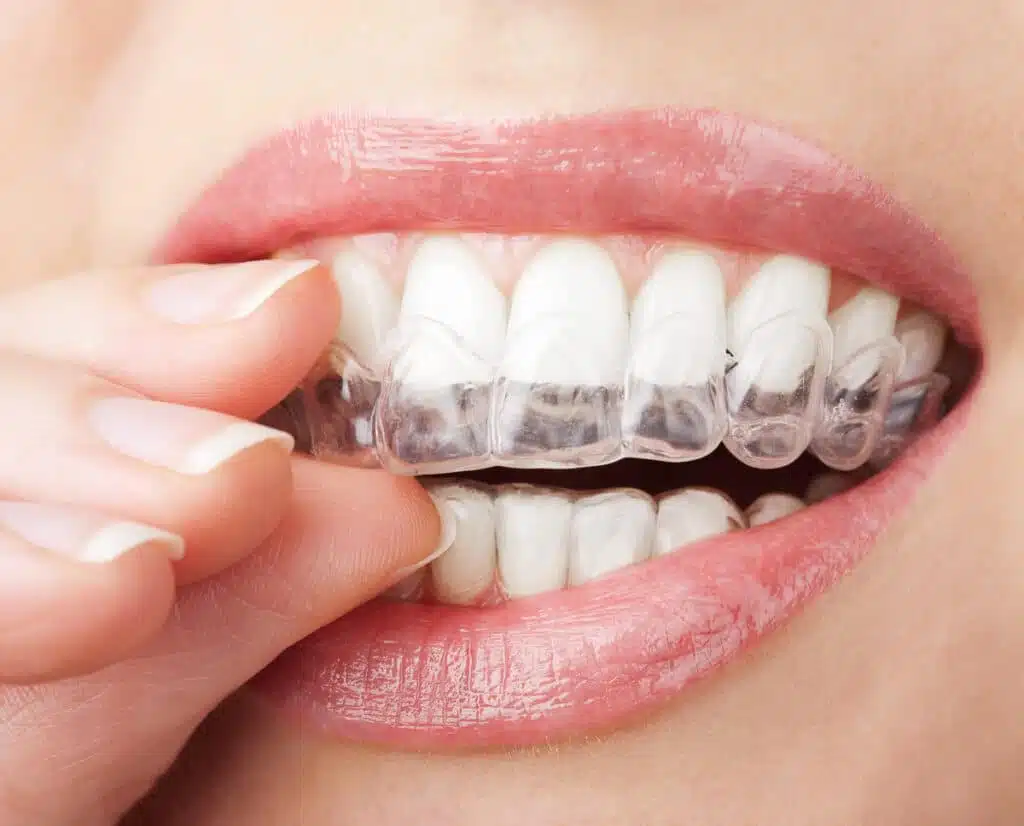White Braces: A discreet Alternative for your Orthodontic Treatment. You’ll find all important Information about the Topic in this Article.
When it comes to achieving a straight and beautiful smile, orthodontic treatments have come a long way.
Gone are the days when traditional metal braces were the only option. Nowadays, individuals seeking a more discreet alternative can choose white braces.
In this article, we will explore what white braces are, their different types, advantages, comparisons to traditional braces, factors to consider, care tips, and answer some common questions.

What are White Braces?
White braces, also known as clear or ceramic braces, are orthodontic appliances designed to straighten teeth while being less noticeable compared to traditional metal braces.
Unlike metal brackets, white braces are made of clear or tooth-colored materials, blending in with the natural color of teeth.
These braces function in a similar way as traditional braces, using a system of brackets and wires to gradually move the teeth into their desired positions.
Types of White Braces
1. Ceramic Braces
Ceramic braces are one of the most popular types of white braces. They consist of clear or tooth-colored brackets that are attached to the teeth and connected by thin archwires.
Ceramic braces are highly effective in teeth straightening and offer a discreet option for those seeking a more aesthetically pleasing solution.
2. Clear Aligners
Clear aligners are a removable type of white braces that have gained significant popularity in recent years.
These aligners are custom-made using clear plastic material and are virtually invisible when worn.
They offer the advantage of being easily removable for eating, brushing, and flossing, providing convenience during orthodontic treatment.
3. Lingual Braces
Lingual braces are another option for individuals looking for a nearly invisible orthodontic treatment.
These braces are placed on the backside of the teeth, making them completely hidden from view.
Lingual braces are custom-made to fit each patient’s teeth, offering effective results without compromising aesthetics.
Advantages of White Braces
1. Aesthetics and Discretion
One of the primary advantages of white braces is their discreet appearance.
The use of clear or tooth-colored materials minimizes the visibility of braces, allowing individuals to smile with confidence throughout their orthodontic journey.
2. Comfort and Minimal Irritation
White braces are designed with patient comfort in mind. The smooth materials used in their construction help reduce irritation and discomfort often associated with traditional metal braces.
With white braces, individuals can experience less gum and cheek irritation.
3. Effective Teeth Straightening
Despite their more subtle appearance, white braces offer the same effectiveness as traditional braces in straightening teeth.
Whether correcting crookedness, gaps, or bite issues, white braces can deliver outstanding results when used as directed by an orthodontist.
4. Customization and Personalization Options
White braces can be customized to suit individual preferences. From choosing tooth-colored brackets to personalized wire configurations, patients have the opportunity to make their orthodontic treatment more unique and tailored to their specific needs.

White Braces vs. Traditional Braces
1. Differences in Appearance
The most noticeable difference between white braces and traditional braces lies in their appearance.
White braces blend in with the natural color of teeth, making them less noticeable, while traditional braces feature metal brackets and wires that are more prominent.
2. Similarities in Functionality and Effectiveness
While the appearance may differ, white braces and traditional braces work in a similar manner.
Both types apply gentle pressure on the teeth to gradually move them into the desired positions, resulting in a straighter smile.
The effectiveness of both types of braces is comparable, with the choice often depending on personal preferences.
3. Considerations for Treatment Duration
The treatment duration for white braces is generally similar to that of traditional braces.
However, some factors such as the complexity of the orthodontic issue and patient compliance can influence the overall treatment time.
It is essential to follow the orthodontist’s instructions to ensure optimal results within the estimated timeframe.
4. Comparisons in Cost and Maintenance
White braces typically cost slightly more than traditional metal braces due to the materials used.
However, the exact cost may vary depending on factors such as the orthodontist’s location and the complexity of the treatment.
In terms of maintenance, white braces require similar care as traditional braces, including regular brushing, flossing, and avoiding certain foods that can damage the braces.
Are White Braces Right for You?
Before choosing white braces, several factors should be considered. Personal preferences, lifestyle, and the severity of the orthodontic issue are all crucial aspects to evaluate.
Consulting with an experienced orthodontist is the best way to determine whether white braces are suitable for your specific case.
The orthodontist will conduct a comprehensive examination and provide personalized recommendations based on your needs and goals.
How to Care for White Braces
Proper care is essential to maintain the appearance and effectiveness of white braces. Here are some care tips to follow:
- Daily Oral Hygiene Routine: Brush your teeth after every meal and floss at least once a day. Use a soft-bristled toothbrush and non-abrasive toothpaste to avoid damaging the braces.
- Foods and Beverages to Avoid: Minimize consumption of sticky or hard foods that can damage the braces. Additionally, limit or avoid beverages that can cause staining, such as coffee, tea, and red wine.
- Regular Dental Check-ups: Maintain regular visits to your dentist for professional cleanings and check-ups. Your dentist can monitor the progress of your orthodontic treatment and address any concerns.
- Handling Potential Staining or Discoloration: If your white braces develop stains or discoloration, consult your orthodontist for possible solutions. They may recommend professional cleaning or provide guidance on effective stain removal methods.
Conclusion on the Topic “White Braces”
White braces provide a discreet and effective solution for individuals seeking orthodontic treatment.
With their aesthetic appeal, comfort, and ability to deliver excellent results, white braces have become a popular choice.
Whether you opt for ceramic braces, clear aligners, or lingual braces, the benefits of white braces go beyond appearance, offering a path to a healthier, more confident smile.
Consult with an experienced orthodontist to determine if white braces are the right choice for you.

FAQs on the Topic “White Braces”
What is the average treatment time for white braces?
The average treatment time for white braces varies depending on the individual case. In general, it can range from several months to a few years. Your orthodontist will provide a more accurate estimate after evaluating your specific needs.
Can I remove white braces myself?
The average treatment time for white braces varies depending on the individual case. In general, it can range from several months to a few years. Your orthodontist will provide a more accurate estimate after evaluating your specific needs.
Will white braces affect my speech?
Initially, white braces may slightly affect your speech as you adjust to having them in your mouth. However, most individuals adapt quickly, and any speech changes are usually temporary. With practice, speech patterns return to normal.
How much do white braces cost?
The cost of white braces can vary depending on factors such as the orthodontist’s location and the complexity of the treatment. On average, the cost of white braces ranges from $3,000 to $7,000. It is best to consult with your orthodontist to get an accurate cost estimate based on your specific needs.
Are white braces suitable for all orthodontic issues?
White braces can address a wide range of orthodontic issues, including crooked teeth, overcrowding, gaps, and bite problems. However, there may be cases where alternative treatments are more suitable. Consulting with an orthodontist will help determine the best treatment option for your specific orthodontic issue.
- About the Author
- More info


Leave a Reply